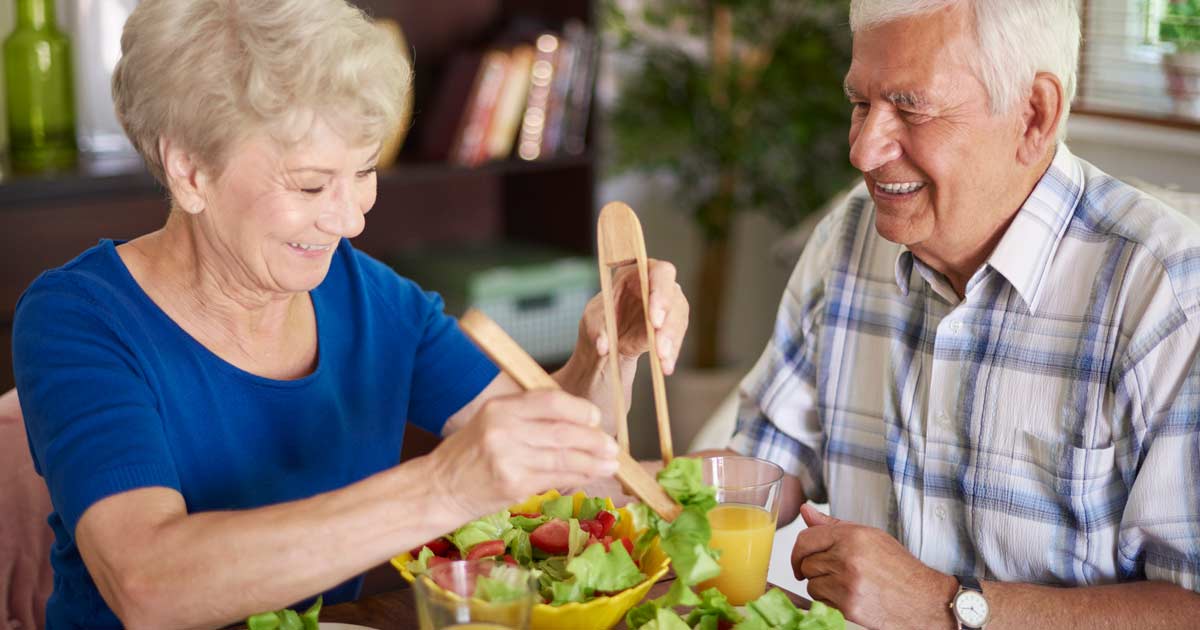Winter and the holidays are coming up fast, so now is the time to create a game plan for healthy eating that will get you through until spring arrives. Unlike during youth, the golden years mean dietary needs change and so should eating habits. Especially during this challenging time with flu season and COVID-19 joining forces, seniors should strive to eat the right foods for their health. These tips can help seniors in independent living get on track and stay there!
Tip #1 — Plan ahead
Seniors who have raised a family know how important it is to plan meals ahead of time, not only to ensure all ingredients are on hand, but also to provide the necessary nutrition. But as the nest empties, it’s easy to get away from meal planning and just eat whatever is available.
And then there’s the convenience factor. It’s so easy to pop a frozen dinner in the microwave and avoid all the hassle of cooking and cleaning up. But the truth is, those frozen meals in plastic dishes are often very high in sodium, contain highly processed portions and are just not that great anyway.
That’s why meal planning is so essential to a healthy diet for seniors in independent living. Even if when just cooking for one, there are plenty of resources available to aid in meal planning and creation. One of the best is the from the National Institute on Aging’s blog, “Sample Menus: Healthy Eating for Older Adults,” which offers links to a wide variety of menus and recipes designed specifically for seniors. They address not only nutritional needs but also calorie intake and sodium content. The blog also offers a sample shopping list that can be printed to take along on shopping trips to help keep purchases in line with the plan.
Tip # 2 — Concentrate on nutrition
As we age, nutritional needs change as well. Short of taking nutritional supplements, recognizing what foods offer the best nutrition for the buck is key to getting enough of each nutrient as often as needed. Some of the most important nutrients for seniors include vitamins B-12 and D, potassium and calcium, and fiber. Also important are Omega-3 fatty acids, iron and magnesium.
The trick is to eat those foods that contain these nutrients while still enjoying what you eat. The GreatSeniorLiving.com blog, “Seniors’ Nutrition: Tips and Guidelines for Healthier Eating,” explores how much of these you need and what foods contain them naturally. Another great list of high-nutrition foods is provided in the Healthline blog, “50 Foods That Are Super Healthy” which looks across the spectrum of foods from fruits and vegetables to grains, nuts and seeds, to eggs, meats, fats, oils, and yes … chocolate! You will likely find several old favorites as well new things to try.
Tip #3 — Snack smart
Snacking is actually a healthy practice, especially for diabetics who need to keep glucose levels in balance. They can also help serving as tasty supplements by adding nutrients missing in other meals. And as long as most snacks are actually nutritious, an occasional sweet snack can be had without guilt or major dietary repercussions. Snacks are also great for keeping mealtime portions in check, rather than overeating. Among the best snacks for seniors are raw fruits and vegetables and those that are high in protein. The Silver Sneakers blog, “8 Best Snacks for Active Older Adults,” zeros in on the later, which are especially good for seniors in independent living. For those with diabetes or pre-diabetes, the American Diabetes Association offers a fact sheet with snack ideas and portioning recommendations.
Tip #4 — Keep an eye on calorie intake
Even the most active seniors should pay attention to calorie intake, especially during the holidays and the more sedentary winter months. Both senior men and women also need fewer calories than they did in younger days to stay healthy, so it stands to reason that eating habits should reflect that lower need.
Beginning at about age 41 for men and age 51 for women, calorie requirements start to decrease, to 2,200 and 1,600 per day, respectively, for sedentary people, and 2,600 and 1,800 for moderately active people. For a complete listing of calories by age and activity level, check out the “Dietary Guidelines 2015-2020” from the U.S. office of Disease Prevention and Health Promotion.
It can also be a real headache trying to stay on top of calorie intake, but modern technology has come to the rescue! The Lifewire blog, “The Best Calorie Counter Apps of 2020” takes an in-depth look at some of the best apps available for both iPhones and Androids, some of which are free and others with small one-time fees or annual subscriptions.
Tip #5 — Minimize sodium
We have all heard it before, sodium is at least in part at fault for high blood pressure, which in turn causes strokes and heart disease. Yet, according to the Centers for Disease Control and Prevention, “About 90% of Americans 2 years old and older consumer too much sodium.”
Sodium is often very high in processed foods and also in restaurant foods because it enhances flavor, so it is always a good practice to read labels and menus before purchasing. Another easy way to limit sodium is to start out with fresh, unsalted foods and prepare meals without additional salt, or in a pinch, look for processed foods like canned vegetables and soup that tout lower sodium content. But even in these cases, read the labels to see just how much salt is contained in a serving while keeping in mind that the daily recommended amount of sodium for both men and women age 51 or more is 2,300 mg (milligrams).
Staying healthy this winter may seem like a rough road ahead, but by keeping these five simple tips in mind, it may become a little smoother. For more information about Countryside, please call Margaret Nagel at (517) 206-5000 or download our brochure to learn about our care levels, cost, and amenities.


